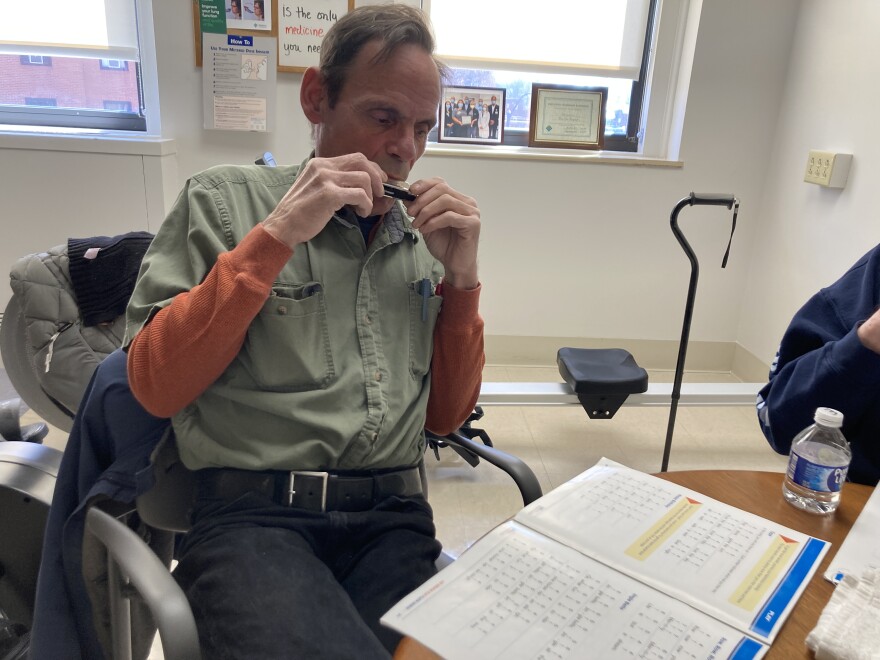A musician needs full lungs to play the harmonica. That makes the pocket-size instrument just what the doctor ordered for respiratory therapy patients at Allegheny Health Network’s West Penn hospital.
The Bloomfield hospital is the latest to implement Harmonicas for Health, a pulmonary rehabilitation program launched as a pilot in 2016 in Murfreesboro, TN and Sioux Falls, SD. More than 30 locations across the U.S. and Canada include the program in their respiratory therapy treatment, which helps patients with types of chronic obstructive pulmonary disease, such as emphysema and chronic bronchitis.
On a recent Wednesday afternoon, patients gathered in a small room on the hospital’s third floor to play songs that get progressively more complicated each week. Today, they’re working on “Taps” and “Row, Row, Row Your Boat.” (“Camp Town Races,” they note, is too difficult to perform for an audience.)

“Take a breather if you need a breather in between,” says West Penn respiratory therapist Becky Jordan.
Playing the harmonica strengthens the diaphragm and teaches pursed-lip breathing, which helps better oxygenate the blood. The technique enables people to inhale and exhale more air, by breathing in through their nose and then breathing out through puckered lips.
These deep, deliberate breaths help patients with damaged lungs inflate microscopic air sacs called alveoli, which are where the blood exchanges CO2 for oxygen. In contrast, breathing quick, shallow breaths will cause the alveoli to collapse, making it harder to get air sacs to inflate again — sort of like when blowing up a balloon, it takes more effort at the beginning. But as the balloon, or air sac, inflates, it takes less breath for it to expand.
Electrician Frank White says learning pursed-lip breathing with the harmonica has kept him out of the hospital, including earlier that morning. After a shower, the oxygen level in his blood dropped to the low 80s; when levels are that low for too long, organ damage can occur, including to the brain. Instead of panicking, White used a home oxygen tank with a nasal cannula and then steadied his breathing with skills he learned by playing the harmonica.
“You’re blowing out, and you’re drawing in, and you have to take deep breaths to maintain it,” said White, “so you have enough breath to go through that part of the song.”
There’s a limited body of research on the effectiveness of playing the harmonica as a form of respiratory therapy, though one 2012 study that focused on patients with COPD found that a harmonica-center curriculum produced roughly the same outcomes as traditional programs. And there are other benefits, says the study’s lead author Jeff Alexander.
“Why not participate in creating music as opposed to just doing live breathing, without the opportunity to learn and develop a new talent, and develop friendships with others in the program they’re with by creating music,” said Alexander, who now specializes in helping older adults maintain their health and independence, as an associate professor at A. T. Still University.
Mary Hart, the president of the Texas Society of Respiratory Care and a fellow of the American Association for Respiratory Care, has used harmonicas in her work. She hopes there will be more research into the benefits of playing the instrument because, in her experience, it helps to keep things interesting for patients: “We, as humans, we get bored, and we quit. And the smiles you see on their faces, it’s worth it.”

AHN’s Jordan agrees that part of the challenge of pulmonary rehab is getting patients to put in the work; finding a fun exercise that builds camaraderie means that people are more likely to keep coming back.
"We’re not at a 100% graduation rate, but our percentages are pretty good…really, the only reason people aren’t continuing the program is for health reasons,” said Jordan, who notes that homebound patients can also practice the harmonica over Zoom, or on their own.
COPD is progressive. Even if patients improve their breathing techniques, their ability to inhale and exhale sufficient amounts of air will decline over time, so being healthy enough to attend therapy is sometimes an issue.
Eventually, Jordan would like to see AHN expand Harmonicas for Health to other respiratory therapy patients, including those with long COVID-19, pulmonary fibrosis, and lung transplant recipients.





